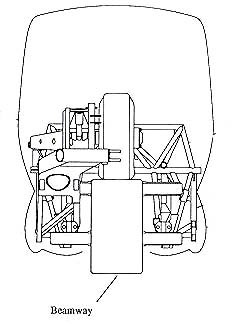Disney/Bombardier Suspension
 The Mark trains use
a slightly different bogie scheme than the Seattle ALWEG and Hitachi
ALWEG monorails. Where the Seattle and Hitachi trains have independent
bogies that have load wheels that extend into the cars, the Mark
III/V, Mark IV and Mark VI trains have load wheels at the ends
of the cars, which are attached to the substructure. Also, instead
of two tires per axle on the Seattle and Hitachi trains, there
is only one on the Mark III/V, IV and VI trains. These load tires
are 445/65R22.5 Michelin XTE2 46.6" diameter , 17.8"
wide truck tires, the same ones you can see on a dump truck or
cement mixer. The tires are nitrogen-filled to reduce the possibility
of fire. They also have run-flat capability. These tires will
last 100,000 miles in normal operation. Maximum rated speed for
these tires is 65 mph (105 km/h). The load capacity of these tires
are 12,800 pounds (5806 kg) each at maximum inflation. There are
12 load tires per 6 car train and 48 guide tires per 6 car train.
These guide tires are 21.5" in diameter. In addition, there
are two steering wheel tires under each cab car to help steer
the suspension up to 3 degrees in either direction. Steering is
accomplished in the intermediate cars by the relative geometry
of the two adjacent cars. Thus, all 12 load tires are steerable,
and the tires are always tangent to the curve. The main suspension
of the cars above the axles is done with air bags (also called
air springs). The air bags are automatically inflated/deflated
by a leveling valve, which allows varying load conditions. There
are also vertical hydraulic shock absorbers. For further information
on the suspension system, see the Bombardier
Mark VI patent. The Mark trains use
a slightly different bogie scheme than the Seattle ALWEG and Hitachi
ALWEG monorails. Where the Seattle and Hitachi trains have independent
bogies that have load wheels that extend into the cars, the Mark
III/V, Mark IV and Mark VI trains have load wheels at the ends
of the cars, which are attached to the substructure. Also, instead
of two tires per axle on the Seattle and Hitachi trains, there
is only one on the Mark III/V, IV and VI trains. These load tires
are 445/65R22.5 Michelin XTE2 46.6" diameter , 17.8"
wide truck tires, the same ones you can see on a dump truck or
cement mixer. The tires are nitrogen-filled to reduce the possibility
of fire. They also have run-flat capability. These tires will
last 100,000 miles in normal operation. Maximum rated speed for
these tires is 65 mph (105 km/h). The load capacity of these tires
are 12,800 pounds (5806 kg) each at maximum inflation. There are
12 load tires per 6 car train and 48 guide tires per 6 car train.
These guide tires are 21.5" in diameter. In addition, there
are two steering wheel tires under each cab car to help steer
the suspension up to 3 degrees in either direction. Steering is
accomplished in the intermediate cars by the relative geometry
of the two adjacent cars. Thus, all 12 load tires are steerable,
and the tires are always tangent to the curve. The main suspension
of the cars above the axles is done with air bags (also called
air springs). The air bags are automatically inflated/deflated
by a leveling valve, which allows varying load conditions. There
are also vertical hydraulic shock absorbers. For further information
on the suspension system, see the Bombardier
Mark VI patent.
|

